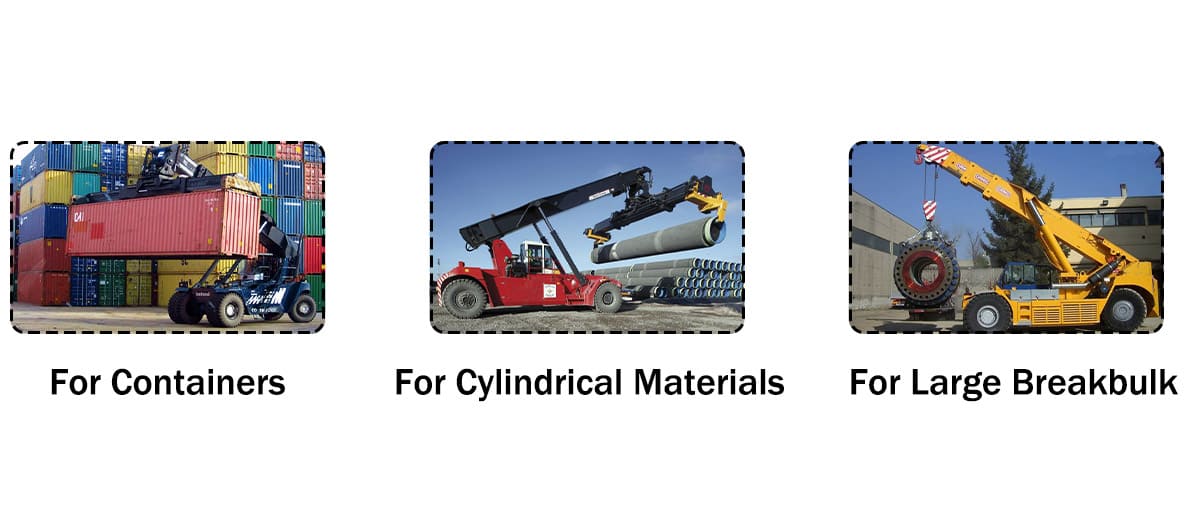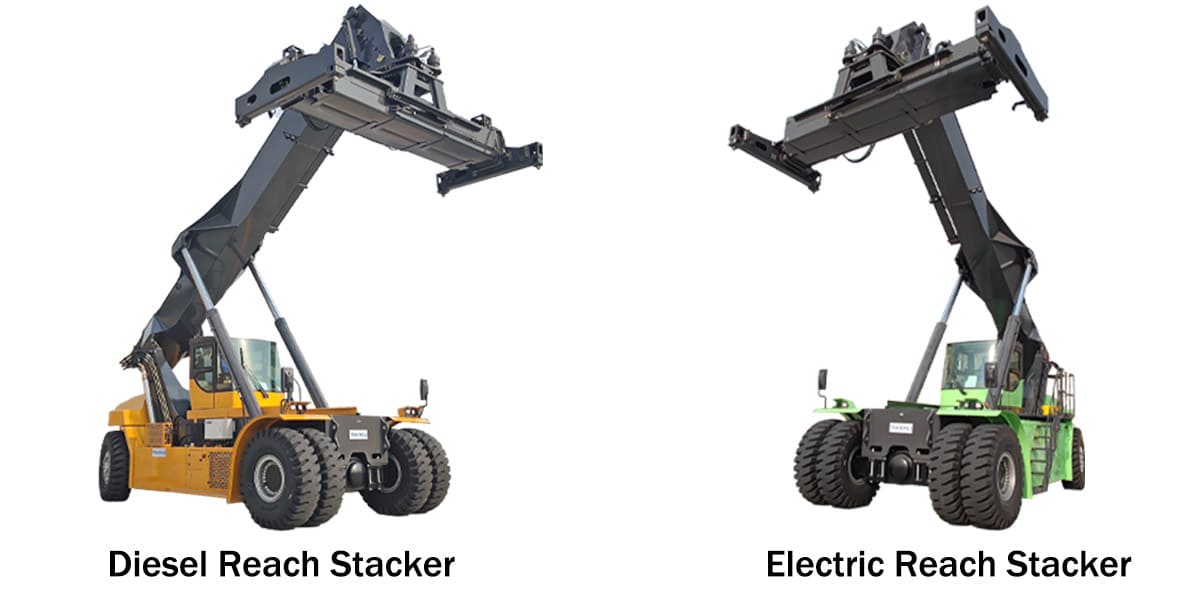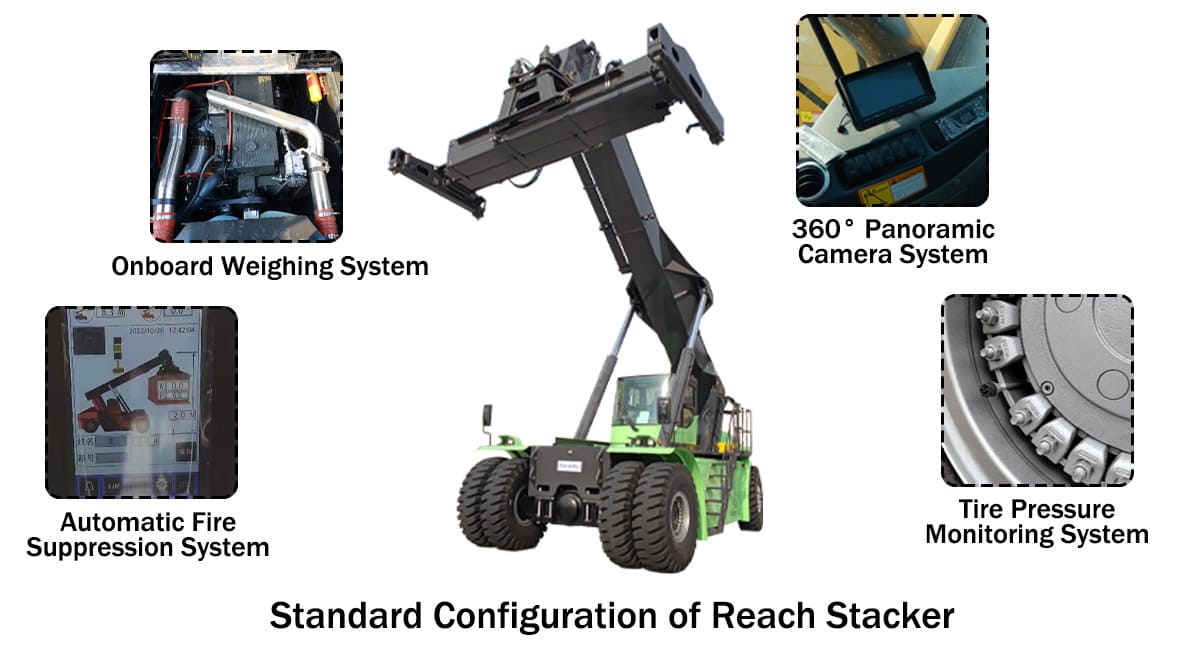Chapter 1: What is A Reach Stacker Function?
Chapter 2: What is A Reach Stacker Used for?
Chapter 3: What is the Cost of Reach Stacker Price?
Chapter 4: What is the Difference Between a Crane and a Reach Stacker?
A container reach stacker is the ultimate solution for modern container handling, combining raw power, intelligent engineering, and unmatched versatility to redefine efficiency in ports, rail yards, and container depots. Built to handle the heaviest loads with absolute precision, the reach stacker is a towering symbol of industrial strength, designed for the rapid loading, unloading, stacking, and transporting of shipping containers in the Sierra Leone most demanding environments.
At its core, the reach stacker function is a specialized type of heavy duty vehicle equipped with a telescopic boom and spreader attachment, capable of lifting and stacking containers up to several rows deep and several layers high. Unlike traditional container cranes or forklifts, the reach stacker delivers exceptional maneuverability, allowing operators to handle containers in tight spaces, quickly position them for storage or loading, and move them across short distances with remarkable speed. This ability to access containers beyond the first row without moving others is a game-changing advantage, saving both time and operational costs.
From the moment you see one in action, the power of a reach stacker price is undeniable. The robust chassis supports massive counterweights and heavy duty axles, enabling it to lift containers weighing up to 45 tons effortlessly. Its telescopic boom extends gracefully yet powerfully, reaching containers stacked three to five rows high or situated behind other rows. Hydraulic precision ensures every movement is smooth and controlled, protecting the valuable cargo and enhancing operator safety.
Operator comfort and control are also at the heart of the reach stacker price design. The spacious, climate-controlled cabin offers panoramic visibility, intuitive joystick controls, and advanced monitoring systems, ensuring that operators can work long shifts without fatigue while maintaining pinpoint accuracy. Many modern reach stackers integrate telematics and automation features, providing data on load weight, boom position, and maintenance requirements in real-time. These smart systems empower fleet managers to optimize usage, schedule maintenance, and enhance productivity.
In terms of versatility, the reach stacker function is second to none. It can handle standard 20-foot and 40-foot containers, high cubes, and even specialized containers with ease. Its spreader attachment adjusts automatically to the container size, and in some models, attachments can be swapped for different cargo handling tasks. This adaptability makes it indispensable not only in shipping terminals but also in intermodal yards, inland depots, and even industrial sites where containers are used for storage or modular operations in Sierra Leone.
Durability is a defining trait of every reach stacker price. Constructed with reinforced steel frames, heavy-duty hydraulics, and precision-engineered components, these machines are built to endure years of heavy use in harsh weather and demanding working conditions in Sierra Leone. Whether under the scorching sun of a coastal port, the freezing temperatures of northern rail yards, or the dusty, rugged terrain of inland logistics hubs, the reach stacker performs without compromise.
The efficiency gains from using a reach stacker price are substantial. Its ability to quickly move containers from ship to yard, yard to truck, or between stacks reduces bottlenecks and maximizes throughput. This not only accelerates the entire supply chain but also minimizes idle time for trucks and vessels, resulting in higher profits and smoother operations. In industries where time is money, this efficiency becomes a competitive edge.
In summary, a container reach stacker price is far more than just a piece of heavy machinery—it is a strategic investment in speed, flexibility, and reliability for any operation that deals with containers. With its combination of strength, reach, precision, and advanced technology, it stands as a critical asset for any modern logistics chain. Whether you operate a busy seaport, an inland container terminal, or an industrial facility, the reach stacker delivers the performance you need to move your business forward, one container at a time.

Reach Stacker Function Price for Sale in Sierra Leone
A reach stacker is one of the most versatile and powerful machines in the world of container and cargo handling, purpose-built to revolutionize how ports, rail yards, and logistics hubs move and store containers. Designed with the perfect balance of strength, precision, and efficiency, a reach stacker function is used to lift, transport, and stack shipping containers with remarkable speed and accuracy—making it an indispensable asset for any operation where containers are the lifeblood of business.
At its core, the reach stacker's job is to handle containers in a way that is faster, more flexible, and more space-efficient than other handling equipment. Equipped with a long, telescopic boom and a specialized spreader attachment, the reach stacker function can pick up containers from trucks, rail cars, or stacks and move them across short to medium distances. It can also place containers several rows deep and multiple levels high, reaching over other rows without having to reposition them. This unique capability dramatically increases storage density in container yards and maximizes the use of available space.
In bustling seaports, a reach stacker function becomes the heartbeat of the operation. It swiftly unloads containers from shipside trucks, positions them for inspection or customs clearance, and stacks them in neat rows ready for pickup. In rail terminals, it moves containers seamlessly between flatcars and storage areas, keeping cargo flowing efficiently between sea and land transport. In inland depots, the reach stacker takes on the role of organizing and storing containers, enabling operators to manage large volumes with minimal space and time.

Reach Stacker Function Price for Sale in Sierra Leone
The versatility of a reach stacker function is not limited to standard 20-foot and 40-foot containers—it can handle high-cube containers, tank containers, and even specialized cargo units with ease. Some models are equipped with interchangeable attachments, allowing them to handle non-containerized loads like logs, steel coils, or bulk goods. This multi-purpose ability makes the reach stacker a cost-effective choice for operators who need one machine to perform multiple roles.
Speed is one of the defining advantages of using a reach stacker function. Its high lifting capacity—often up to 45 tons—combined with fast boom extension and rotation ensures rapid container turnover. This translates to reduced waiting times for trucks, faster train loading, and fewer delays in overall cargo movement. The more quickly containers are moved, the more shipments can be processed, increasing productivity and profitability for Sierra Leone’s customers.
Precision handling is equally important, and reach stacker price excel in this area. Advanced hydraulic systems and operator-friendly controls allow for smooth, accurate positioning of containers, even when stacking to the highest levels. The elevated operator cab, often with wide panoramic windows and ergonomic controls, gives the driver a clear view of the work area, enhancing both safety and accuracy.
In addition to efficiency and precision, the reach stacker function brings significant operational flexibility. Unlike gantry cranes, which are fixed to one location, a reach stacker is mobile and can operate anywhere within the yard. It can quickly adapt to changing workloads, move to different areas as needed, and handle both incoming and outgoing cargo without complicated repositioning.
From a business perspective, using a reach stacker function means lower infrastructure costs and higher adaptability. Because it can work in confined spaces and handle containers stacked several rows deep, operators can reduce the footprint of their storage yards. This is especially valuable in high-cost land areas, where maximizing storage density directly impacts profitability.
In short, a reach stacker is used to maximize container handling efficiency, increase storage capacity, and enhance operational flexibility across a wide range of cargo-handling environments. Whether in Sierra Leon’s ports, rail yards, or inland logistics hubs, it is the ultimate machine for moving containers quickly, safely, and precisely. For businesses that demand speed, reliability, and the ability to handle high volumes with minimal space, the reach stacker function is not just a tool—it's the backbone of a smooth and profitable logistics operation.

Reach Stacker Function Price for Sale in Sierra Leone
The cost of a reach stacker price is more than just a number—it is a strategic investment in efficiency, speed, and long term profitability for any operation that handles shipping containers. When you choose a reach stacker, you are not merely buying a machine; you are securing a cornerstone of your logistics infrastructure, one that can transform how you move, stack, and store containers in Sierra Leone port, rail yard, or inland depot.
The cost of a reach stacker varies significantly depending on multiple factors, and understanding these variables is key to making the right purchase decision. First and foremost, capacity plays a major role. Reach stackers are designed to handle heavy loads, with many models capable of lifting up to 45 tons in the first row and slightly less in deeper rows. Machines with higher lifting capacity, extended reach, or special attachments naturally come at a higher price point, reflecting their greater versatility and strength.
Technology and features are another major cost driver. Modern reach stacker price can be equipped with advanced hydraulic systems, fuel-efficient engines, automated control systems, load monitoring displays, and telematics for real-time performance tracking. These smart features improve operational efficiency, reduce downtime, and enhance safety, but they also influence the purchase price. Investing in technology-rich models often pays off through reduced operating costs and higher productivity over the machine's lifetime.
The brand and manufacturing quality also affect cost. Established brands with a reputation for reliability, durability, and comprehensive after-sales service often command higher prices because their equipment is built to last under the most demanding conditions. A premium-quality reach stacker price may require a larger initial investment, but it can save money in the long run by minimizing repair costs and extending service life.
Customization is another factor that can influence cost. Depending on your operational needs, you may require specialized spreaders for non-standard containers, reinforced booms for heavy-duty applications, or additional comfort features for the operator cabin. Each customization adds value but also impacts the overall price.
When evaluating cost, it is important to consider the total cost of ownership, not just the initial purchase price. Fuel efficiency, maintenance requirements, spare parts availability, and resale value all play a role in determining the true financial impact of your investment. A reach stacker with a slightly higher purchase cost but lower fuel consumption and longer service intervals could end up being the more economical choice over its lifespan.
For Sierra Leone businesses with high container turnover, the return on investment (ROI) can be remarkably fast. By significantly reducing container handling times and maximizing yard space usage, a reach stacker price can increase operational throughput, allowing more cargo to be processed in less time. This efficiency can translate directly into higher revenue, making the initial investment well worth it.
It's also worth noting that the cost of a reach stacker function can vary by region due to factors such as import duties, shipping costs, and local demand. Additionally, buyers can explore options such as certified pre-owned machines, which offer a balance between affordability and reliability, or financing plans that spread the cost over manageable payments.
In summary, the cost of a reach stacker function is influenced by capacity, features, brand quality, customization, and total cost of ownership. While it represents a significant capital investment, a reach stacker is not an expense—it is an asset that pays dividends in speed, flexibility, and operational excellence. For any business that relies on efficient container handling, the right reach stacker price is worth every cent, delivering value day after day, container after container.

Reach Stacker Function Price for Sale in Sierra Leone
When it comes to container handling, both the crane and the reach stacker function are iconic machines—but they serve different purposes, operate in different ways, and deliver unique advantages. Understanding the difference between these two powerhouse tools is essential for anyone who wants to maximize efficiency, optimize space, and choose the right equipment for their logistics operation.
A crane, whether it's a gantry crane in a port or a mobile crane in a yard, is designed for lifting containers vertically and moving them over fixed or semi-fixed paths. Gantry cranes, for example, are built to straddle stacks of containers or dockside areas, lifting cargo directly from a ship to a truck or storage area. They are known for enormous lifting capacity, precision in vertical movement, and the ability to handle massive ships and heavy-duty container loads. Cranes are typically fixed in place or have limited mobility, making them ideal for operations with high, concentrated container volumes in a set location.
On the other hand, a reach stacker function is the master of mobility and flexibility. Unlike a crane, it can drive freely around the yard, picking up containers from one spot and moving them to another with speed and agility. Its telescopic boom allows it to stack containers several rows deep and up to five containers high, reaching over other rows without having to reposition them. This gives Sierra Leone operators the ability to maximize storage density in small or irregular spaces—something a fixed crane cannot achieve.
One of the most significant differences lies in space efficiency. A crane requires a dedicated operational footprint and infrastructure, including rails, foundations, and sometimes even special yard layouts. Once installed, its position is mostly fixed, and its reach is determined by its size and design. A reach stacker, however, thrives in both large open yards and compact inland depots, able to maneuver around obstacles and handle containers in multiple locations without additional infrastructure.
Operational speed is another key difference. While cranes excel in heavy lifting for large ships or high volume container stacks, they often operate in a structured, linear process. Reach stackers, with their ability to move quickly between pick-up and drop-off points, are better suited for dynamic operations where containers are constantly being rearranged, moved for Sierra Leone customs inspection, or loaded onto different modes of transport.
In terms of investment, cranes represent a long-term, high-capacity infrastructure commitment, often with a high purchase and installation cost but delivering exceptional throughput for very large-scale operations. Reach stacker price, though also a significant investment, are generally more affordable and offer a faster return on investment for operations with varied or rapidly changing container handling needs.
From the Sierra Leone operator's perspective, the difference is equally striking. Cranes require highly skilled operators who control complex lifting systems from a cab high above the ground or from a control room. Reach stacker price, by contrast, place the operator in a comfortable, high-visibility cabin with intuitive controls, offering a more agile and hands-on container handling experience.
In summary, the crane is the heavyweight champion for static, high-volume lifting—perfect for massive ship-to-shore operations—while the reach stacker function is the agile, all-terrain athlete, excelling in mobile, flexible, and space-efficient container handling. Choosing between the two depends on your operational scale, space availability, and the nature of your container movement. For fixed-location, ultra-heavy lifting, the crane reigns supreme. For Sierra Leone yard versatility, speed, and adaptability, the reach stacker function stands unrivaled.

Reach Stacker Function Price for Sale in Sierra Leone